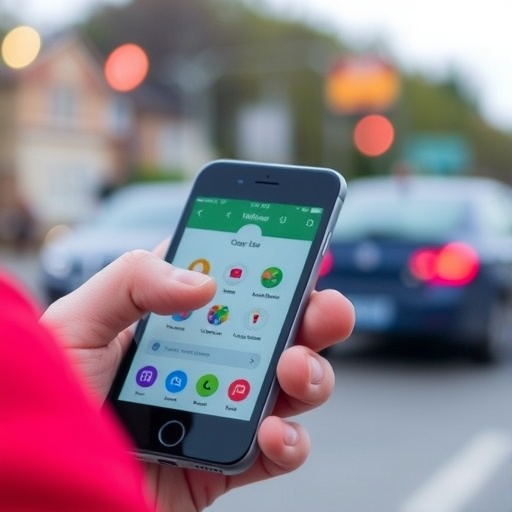A groundbreaking advancement in the field of cognitive science is paving the way for novel insights into the increasingly critical issue of vigilance and attention. Researchers have developed a mobile application that leverages digital tools to assess impaired vigilance among users. This innovative technology not only holds promise for understanding cognitive decline but also offers an accessible platform for widespread use, catering to individuals’ productivity and mental well-being.
The urgency for tools assessing vigilance arises from modern lifestyles that aggressively challenge human attention spans. Entangled with an ever-increasing array of distractions, individuals find themselves battling to maintain focus and clarity. Understanding how these distractions impact vigilance is now integral to improving psychological health in our technology-driven world. The new mobile application will potentially reshape our approach to tackling these pervasive issues, creating a bridge between practical application and scientific inquiry.
The developers of this app, Pahari, Schmitz, Richert, and their team, have leveraged cutting-edge research that explores the underlying mechanisms behind attention deficits. The mobile application harnesses cognitive tasks designed to evaluate the user’s ability to sustain attention over time. By employing a rigorous methodological framework, they aim to provide insights into factors that contribute to lapses in vigilance. This tool is positioned to fundamentally shift how we measure cognitive performance outside of traditional laboratory settings.
One of the most compelling aspects of the application is its user-friendly interface that can seamlessly integrate into a user’s daily routine. Unlike conventional testing methods, which often require substantial time investments and a controlled environment, this app can assess vigilance in real-time and in naturalistic settings. This adaptability makes it a transformative tool for both researchers and the public, as users can gain immediate feedback on their cognitive functioning.
The design of the application draws inspiration from behavioral science and human-computer interaction principles. By engaging users through interactive tasks, the app minimizes the potential for boredom—a common pitfall in cognitive assessments. This engagement is pivotal for encouraging consistent usage and adherence, fostering an environment where users are more likely to return and track their cognitive performance over time.
The research team paid meticulous attention to the validity and reliability of the app’s assessments. Extensive validation studies were conducted to ensure that the app delivers accurate measures of vigilance comparable to traditional testing methods. Users can be confident that their results accurately reflect their cognitive state. As claims of digital assessments proliferate, the meticulous validation process stands out as a hallmark of responsible innovation in this domain.
Feedback from initial beta testers has been overwhelmingly positive, highlighting the app’s potential utility for diverse demographics. Students, professionals, and even older adults have reported increased awareness of their cognitive performance and its implications for everyday functioning. The app could serve as a critical tool for educational institutions and workplaces aiming to promote better mental health and productivity among their members.
Moreover, the implications of this research extend far beyond individual assessments. The data collected through the app can be aggregated for broader analysis, providing researchers valuable insights into vigilance trends in specific populations. This large-scale data collection paves the way for potential interventions based on demographic and behavioral correlations, allowing for targeted strategies to enhance attentional capabilities in various communities.
As the prevalence of distractions due to digital environments continues to rise, understanding vigilance has become more urgent. The team’s research adds vital knowledge in this field, addressing a notable gap in our understanding of how digital distractions can impair cognitive functioning. Effective responses to attentional impairments can lead to enhanced performance in professional and academic settings, driving improved outcomes for individuals and organizations alike.
The mobile application is not just a tool for measurement; it has the potential to inform educational practices and corporate training programs. By identifying periods of decreased vigilance, users can strategize when to take breaks or employ focus-enhancing techniques, such as mindfulness or structured tasks. This proactive approach encourages users to take ownership of their mental efficiency.
Interestingly, the application also opens discussions around the ethics of cognitive assessment and monitoring. As technology becomes increasingly interwoven with our lives, understanding the implications of using such digital tools for monitoring cognitive states is essential. Researchers and users alike must navigate the complexities of privacy and data security, ensuring that the engagement with the app is both beneficial and ethically sound.
The future of cognitive assessments seems poised for evolution with innovations like this mobile application. As these digital tools become more prevalent, society must recognize the importance of vigilance as a metric for personal performance and overall well-being. The intersection of technology and cognitive science signals a change in how we can assess, understand, and ultimately enhance our cognitive processes in a rapidly changing world.
In conclusion, this novel mobile application represents a significant advancement in cognitive research, offering an accessible, user-friendly platform for assessing vigilance. With its rigorous scientific foundation and potential for real-world application, it stands to change the narrative surrounding attention in our distraction-laden lives. Researchers and users alike eagerly anticipate the app’s full impact, hoping it provides meaningful insights into improving human cognitive performance.
This innovation exemplifies the exciting possibilities of integrating technology with cognitive science, highlighting the importance of continued research and practical applications in this dynamic field. As we move further into the digital age, tools like this one will play a pivotal role in shaping our understanding of human attention and cognitive function.
Subject of Research: Cognitive assessment of vigilance through mobile technology.
Article Title: A novel mobile application to examine impaired vigilance through digital means.
Article References:
Pahari, P., Schmitz, L., Richert, E. et al. A novel mobile application to examine impaired vigilance through digital means.
Sci Rep 15, 39115 (2025). https://doi.org/10.1038/s41598-025-23155-z
Image Credits: AI Generated
DOI: https://doi.org/10.1038/s41598-025-23155-z
Keywords: Cognitive assessment, vigilance, mobile application, digital tools, attention, psychological health, user engagement, behavioral science, data collection, ethics, cognitive decline, mental well-being, productivity.




